This post was originally published on this site
A century ago, science’s understanding of the brain was primitive, like astronomy before telescopes. Certain brain injuries were known to cause specific problems, like loss of speech or vision, but those findings offered a fuzzy view.
Anatomists had identified nerve cells, or neurons, as key components of the brain and nervous system. But nobody knew how these cells collectively manage the brain’s sophisticated control of behavior, memory or emotions. And nobody knew how neurons communicate, or the intricacies of their connections. For that matter, the research field known as neuroscience — the science of the nervous system — did not exist, becoming known as such only in the 1960s.
Over the last 100 years, brain scientists have built their telescopes. Powerful tools for peering inward have revealed cellular constellations. It’s likely that over 100 different kinds of brain cells communicate with dozens of distinct chemicals. A single neuron, scientists have discovered, can connect to tens of thousands of other cells.
Yet neuroscience, though no longer in its infancy, is far from mature.
Today, making sense of the brain’s vexing complexity is harder than ever. Advanced technologies and expanded computing capacity churn out torrents of information. “We have vastly more data … than we ever had before, period,” says Christof Koch, a neuroscientist at the Allen Institute in Seattle. Yet we still don’t have a satisfying explanation of how the brain operates. We may never understand brains in the way we understand rainbows, or black holes, or DNA.
Deeper revelations may come from studying the vast arrays of neural connections that move information from one part of the brain to another. Using the latest brain mapping technologies, scientists have begun drawing detailed maps of those neural highways, compiling a comprehensive atlas of the brain’s communication systems, known as the connectome.
Those maps are providing a more realistic picture than early work that emphasized the roles of certain brain areas over the connections among them, says Michael D. Fox, a neuroscientist who directs the Center for Brain Circuit Therapeutics at Brigham and Women’s Hospital in Boston.
Scientists now know that the dot on the map is less important than the roads leading in and out.
“With the building of the human connectome, this wiring diagram of the human brain, we all of a sudden had the resources and the tools to begin to look at [the brain] differently,” Fox says.
Scientists are already starting to use these new brain maps to treat disorders. That’s the main goal of Fox’s center, dedicated to changing brain circuits in ways that alleviate disorders such as Parkinson’s disease, obsessive-compulsive disorder and depression. “Maybe for the first time in history, we’ve got the tools to map these symptoms onto human brain circuits, and we’ve got the tools to intervene and modulate these circuits,” Fox says.
The goal sounds grandiose, but Fox doesn’t think it’s a stretch. “My deadline is a decade from now,” he says.
Whether it’s 10 years from now or 50, by imagining what’s ahead, we can remind ourselves of the progress that’s already been made, of the neural galaxies that have been discovered and mapped. And we can allow ourselves a moment of wonder at what might come next.
The three fictional vignettes that follow illustrate some of those future possibilities. No doubt they will be wrong in the details, but each is rooted in research that’s under way today, as described in the “reality checks” that follow each imagined scenario.
Science future: brain bots
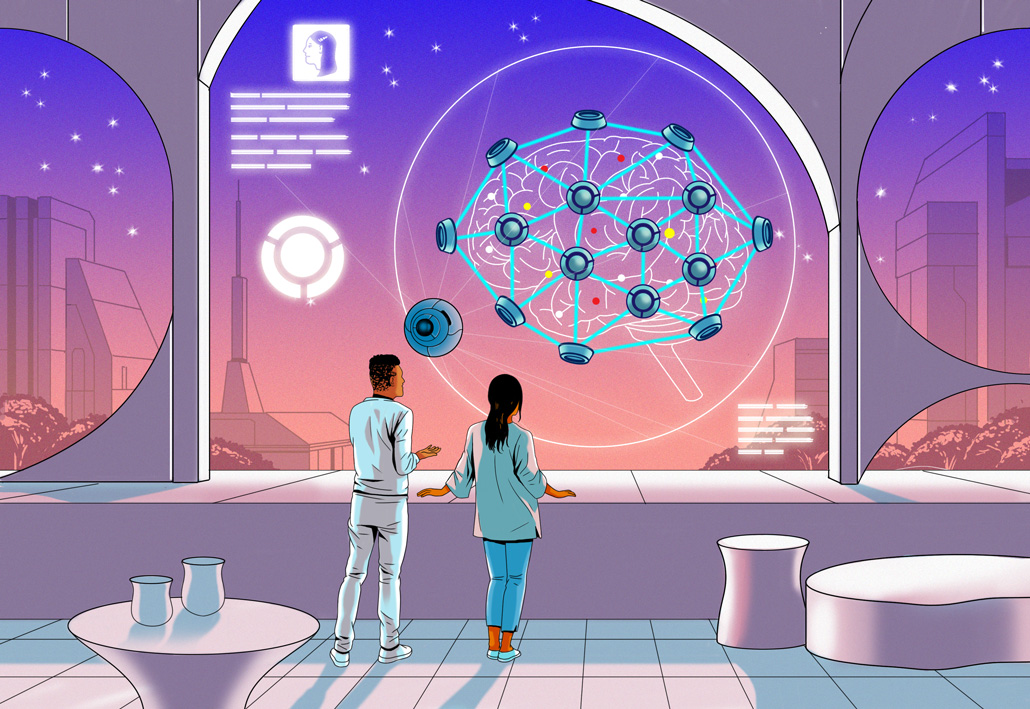
What if nanobots could slide into the brain to end a bout of depression before it started? Glenn Harvey
Sarah had made up her mind. After five years, she was going to get her neural net removed. The millions of nanobots in her brain had given her life back to her, by helping her mind to work again. They had done their job. It was time to get them out.
After Sarah’s baby was born on the summer solstice, things got dark. The following months had tipped Sarah into a postpartum depression that kept her from enjoying her gorgeous, perfect little girl.
Unable to feel much of anything, Sarah barely moved through those early days. She rarely looked at the baby. She forgot to eat. She would sit in a dark room for hours, air conditioner on full blast, staring at nothing. Those endless days stretched until an unseasonably hot September morning. Her mother watched the baby while Sarah’s husband drove her to the Institute for Neuroprosthetics, a low-slung brick building in the suburbs of Nashville.
Inside, Sarah barely listened as the clinic coordinator described the technology again. An injection would deliver the nanobots to her blood. Then a tech would guide the bots, using a magnet, from her arm toward her head. A fast, strong pulse of ultrasound would open the blood-brain barrier temporarily, allowing an army of minuscule particles to slip in.
Powered by the molecular motion inherent in the brain, the nanobots would spread out to form a web of microscopic electrodes. That neural network could pinpoint where Sarah’s brain circuitry was misfiring and repair it with precise but persuasive electrical nudges.
Over the following weeks, Sarah’s nanobots learned the neural rhythms of her brain as she moved through her life with debilitating depression. With powerful computational help — and regular tinkering by the clinic technologist — the system soon learned to spot the earliest neural rumblings of a deteriorating mood. Once those warning signs were clear, Sarah’s web of nanobots could end budding episodes before they could take her down.
Soon after the injection, Sarah’s laugh started to reappear, though sometimes at the wrong times. She recalled the day she and her husband took the baby to a family birthday party. In the middle of a story about her uncle’s dementia treatment, Sarah’s squawks of laughter silenced the room.
Those closest to her understood, but most of her family and friends didn’t know about the millions of bots working to shore up her brain.
After a few months and some adjustments, Sarah’s emotions evened out. The numb, cold depression was gone. Gone too were the inappropriate bursts of laughter, flashes of white rage and insatiable appetites. She was able to settle in with her new family, and feel — really feel — the joy of it all.
But was this joy hers alone? Maybe it belonged to the army of tiny, ever-vigilant helpers, reworking and evening out her brain. Without her neural net, she might have been teary watching her daughter, still her baby, walk into her kindergarten classroom on the first day. Instead, Sarah waved, turned and went to work, feeling only slightly wistful, nothing more intense than that.
The science supporting the success of neural nets was staggering. They could efficiently fix huge problems: addiction, dementia, eating disorders and more. But the science couldn’t answer bigger questions of identity and control — what it means to be a person.
That search for herself is what drove Sarah back to the clinic, five years after she welcomed the nanobots in.
Her technologist went over the simple extraction procedure: a quick ultrasound pulse to loosen the blood-brain barrier again, a strong magnet over the inside of Sarah’s elbow and a blood draw. He looked at her. “You ready?”
She took a deep breath. “Yes.”
Reality check: brain bots
In this story, Sarah received a treatment that doesn’t exist in the real world. But the idea that scientists will be able to change certain brain networks — and improve health — is not fiction. It’s happening.
Already, a technique known as deep brain stimulation, or DBS, uses electrodes surgically implanted in people’s brains to tweak the behavior of brain cells. Such electrode implants are helping reduce Parkinson’s tremors, epileptic seizures and uncontrollable movements caused by Tourette’s syndrome. Mood disorders like Sarah’s have been targeted too.
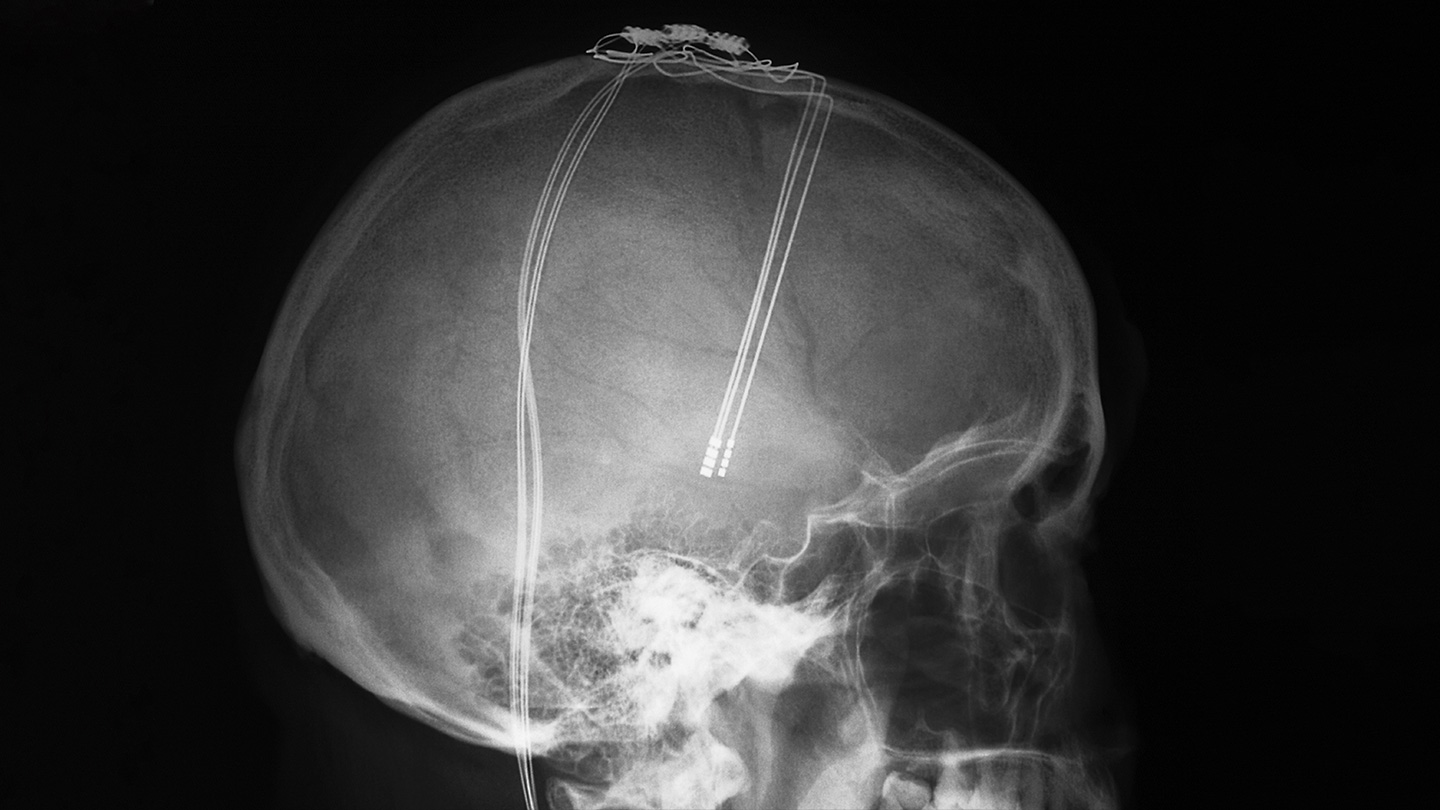
The central idea of DBS — that the brain can be fixed by stimulating it — is not new. In the 1930s, psychiatrists discovered that a massive wallop of seizure-inducing electricity could sometimes relieve psychiatric symptoms. In the 1940s and 1950s, researchers studied whether more constrained electrical stimulation could help with disorders such as depression.
In 1948, for instance, neurosurgeon J. Lawrence Pool of Columbia University’s Neurological Institute of New York implanted electrodes to stimulate the brain of a woman with severe Parkinson’s who had become depressed and lost weight. Soon, she began to “eat well, put on weight and react in a more cheerful manner,” Pool reported in 1954.
The experiment ended three years later when one of the wires broke. “It is the writer’s conviction that focal controlled stimulation of the human brain is a new technique in psychosurgery that is here to stay,” Pool wrote.
Compared with those early days, today’s scientists understand a lot more about how to selectively influence brain activity. But before a treatment such as Sarah’s is possible, two major challenges must be addressed: Doctors need better tools — nimble and powerful systems that are durable enough to work consistently inside the brain for years — and they need to know where in the brain to target the treatment. That location differs among disorders, and even among people.
These are big problems, but the various pieces needed for this sort of precision healing are beginning to coalesce.
The specs of the technology that will be capable of listening to brain activity and intervening as needed is anyone’s guess. Yet those nanobots that snuck into Sarah’s brain from her blood do have roots in current research. For example, Caltech’s Mikhail Shapiro and colleagues are working toward nanoscale robots that roam the body and act as doctors (SN: 10/10/20 & 10/24/20, p. 27).
Other kinds of sensors are growing up, fast. In the last 20 years, electrodes have improved by an astonishing amount, becoming smaller, more flexible and less likely to scar the brain, says biomedical engineer Cynthia Chestek. When she began working on electrode development in the early 2000s, there were still insolvable problems, she says, including the scars that big, stiff electrodes can leave, and the energy they require to operate. “We didn’t know if anybody was ever going to deal with them.”
But those problems have largely been overcome, says Chestek, whose lab team at the University of Michigan in Ann Arbor develops carbon fiber electrodes. Imagine the future, Chestek says. “You could have thousands of electrodes safely interfacing with neurons. At that point, it becomes really standard medical practice.”
Neural dust — minuscule electrodes powered by external ultrasounds — already can pick up nerve and muscle activity in rats. Neuropixels can record electrical activity from over 10,000 sites in mice’s brains. And mesh electrodes, called neural lace, have been injected into the brains of mice.
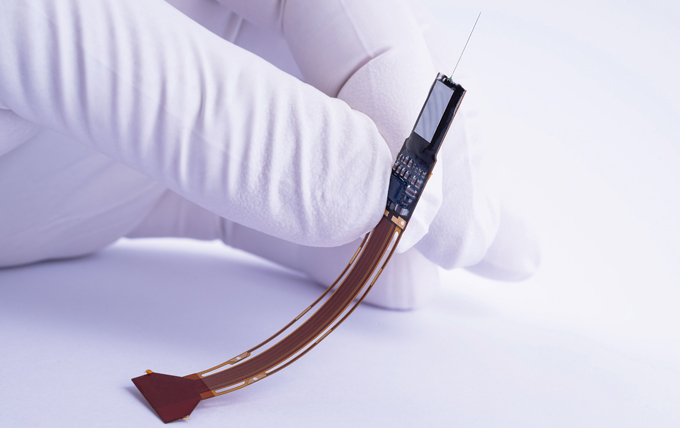
Once inside, these nets integrate into the tissue and record brain activity from many cells. So far, these mesh electrodes have captured neural activity over months as the mice have scurried around.
Other systems under development can be controlled with magnets, light or ultrasound. There are still problems to solve, Chestek says, but none are insurmountable. “We just need to figure out the last set of practical tricks,” she says.
Once scientists know how to reliably change brain activity, they need to know where to make the change. Precision targeting is complicated by the fact that ultimately, every part of the brain is connected to every other part, in a very Kevin Bacon way.
Advances in tractography — the study of the physical connections among groups of nerve cells — are pointing to which parts of these neural highways could be targeted to deal with certain problems.
Other studies of people with implanted electrodes reveal brain networks in action. When certain electrodes were stimulated, people experienced immediate and obvious changes in their moods (SN: 2/16/19, p. 22). Those electrodes were near the neural tracts that converge in a brain region just behind and above the eyes called the lateral orbitofrontal cortex.
In the future, we might all have our personalized brain wiring diagrams mapped, Fox says. And perhaps for any symptom — anxiety, food craving or addiction — doctors could find the brain circuit responsible. “Now we’ve got our target,” he says. “We can either hold the neuromodulation tool outside your scalp, or implant a tool inside your head, and we’re going to fix that circuit.”
The hurdles to building a nimble, powerful and precise system similar to the one that helped Sarah are high. But past successes suggest that innovative, aggressive research will find ways around current barriers. For people with mood disorders, addiction, dementia or any other ailment rooted in the brain, those advances can’t come soon enough.
Science future: mind meld
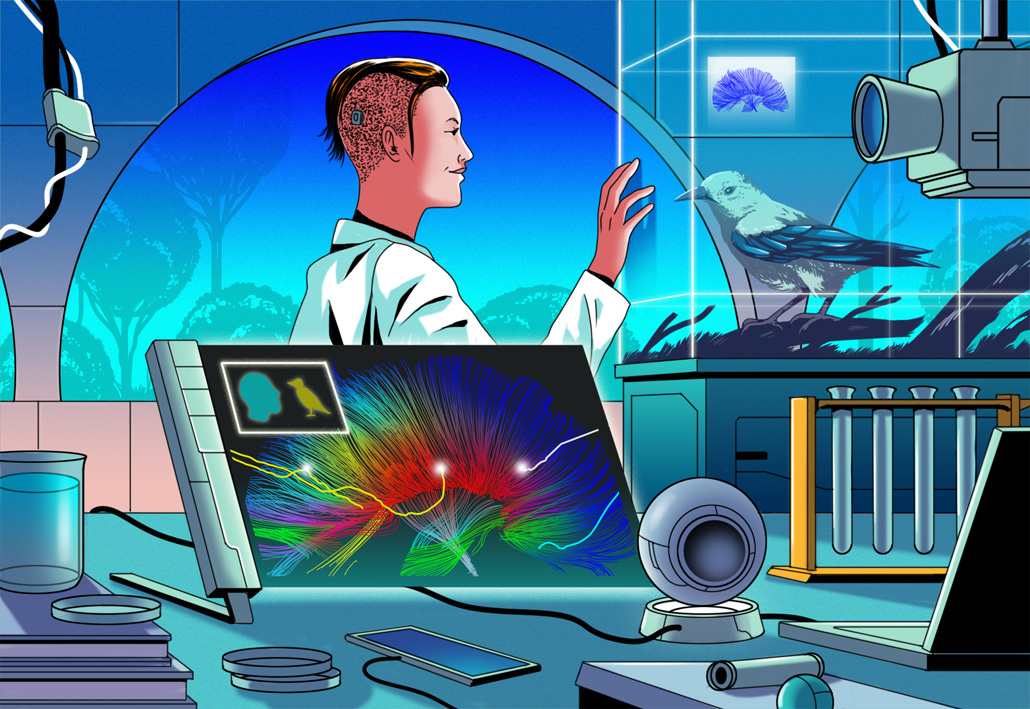
Sofia couldn’t sleep. Tomorrow was the big day. As the project manager for the Nobel Committee for Physiology or Medicine, she had overseen years of prize announcements, but never one like this.
At 11:30 a.m. Central European Summer Time tomorrow, the prize would be given to a bird named Harry, a 16-year-old Clark’s nutcracker. Sofia smiled in the dark as she thought about how the news would land.
Harry was to be recognized for benefiting humankind “in his role as a pioneering memory collective that enhances human minds.” Harry would share the prize (and the money) with his two human trainers.
Tomorrow morning, the world would be buzzing, Sofia knew. But as with every Nobel Prize, the story began long before the announcement. Even in the 20th century, scientists had been dreaming of, and tinkering with, merging different kinds of minds.
As the technology got more precise and less invasive, human-to-human links grew seamless, inspired by ancient and intriguing examples of conjoined twins with shared awareness. External headsets could send and receive signals between brains, such as “silent speech” and sights and sounds.
Next, scientists began looking to other species’ brains for different types of skills that might boost our human abilities. Other animals have different ways of seeing, feeling, experiencing and remembering the world. That’s where Harry came in.
Crows, ravens and other corvids have prodigious memories. That’s especially true for Clark’s nutcrackers. These gray and black birds can remember the locations of an estimated 10,000 seed stashes at any given time. These powerful memory abilities soon caught the eye of scientists eager to augment human memory.
The scientists weren’t talking about remembering where the car is parked in the airport lot. They set their sights higher. Done right, these enhancements could allow a person to build stunningly complete internal maps of their world, remembering every place they had ever been. And it turned out that these memory feats didn’t just stop at physical locations. Strengthening one type of memory led to improvements in other kinds of memories too. The systems grew stronger all around.
Harry wasn’t the first bird to link up with humans, but he has been one of the best. As a young bird, Harry underwent several years of intense training (aided by his favorite treat, whitebark pine seeds). Using a sophisticated implanted brain chip, he learned to merge his neural signals with those of a person who was having memory trouble or needed a temporary boost. The connection usually lasted for a few hours a day, but its effects endured. Noticeable improvements in people’s memories held fast for months after a session with Harry. The people who tried it called the change “breathtaking.” The bird had made history.
By showing this sort of human-animal mind meld was possible, and beneficial, Harry and his trainers had helped create an entirely new field, one worthy of Nobel recognition, Sofia thought.
Some scientists are now building on what Harry’s brain could do during these mingling sessions. Others are expanding to different animal abilities: allowing people to “see” in the dark like echolocating bats, or “taste” with their arms like octopuses. Imagine doctors being able to smell diseases, an olfactory skill borrowed from dogs. News outlets were already starting to run interviews with people who had augmented animal awareness.
Still wide awake, Sofia’s mind ran back through the meetings she had held with her communications team over the last week. Tomorrow’s announcement would bring amusement and delight. But she also expected to hear strong objections, from religious groups, animal rights activists and even some ethicists concerned about species blurring. The team was prepared for protests, lots of them.
In the middle of the night, these worries seemed a smidge more substantial to Sofia. Then she thought of Harry flitting around, hiding seeds, and the threat faded away. Sofia marveled at how far the science had come since she was a girl, and how far it was bound to go. Fully exhausted, she rolled over, ready to sleep, ready for tomorrow. She smiled again as she thought about what she’d tell people, if the chance arose: For better or worse, resistance is futile.
Reality check: mind meld
Accepting that a bird could win a Nobel Prize demands a pretty long flight of fancy. But scientists have already directly linked together multiple brains.
Today, the technology that makes such connections possible is just getting off the ground. We are in the “Kitty Hawk” days of brain interface technologies, says computational neuroscientist Rajesh Rao of the University of Washington in Seattle, who is working on brain-based communication systems. In the future, these systems will inevitably fly higher.
Such technology might even take people beyond the confines of their bodies, creating a sort of extended cognition, possibly enabling new abilities, Rao says. “This direct connection between brains — maybe that’s another way we can make a leap in our human evolution.”
Rao helped organize a three-way direct brain chat, in which three people sent and received messages using only their minds while playing a game similar to Tetris. Signals from the thoughts of two players’ brains moved over the internet and into the back of the receiver’s brain via a burst of magnetic stimulation designed to mimic information coming from the eyes.
Senders could transmit signals that told the receiver to rotate a piece, for instance, before dropping it down. Those results, published in 2019 in Scientific Reports, represent the first time multiple people have communicated directly with their brains.
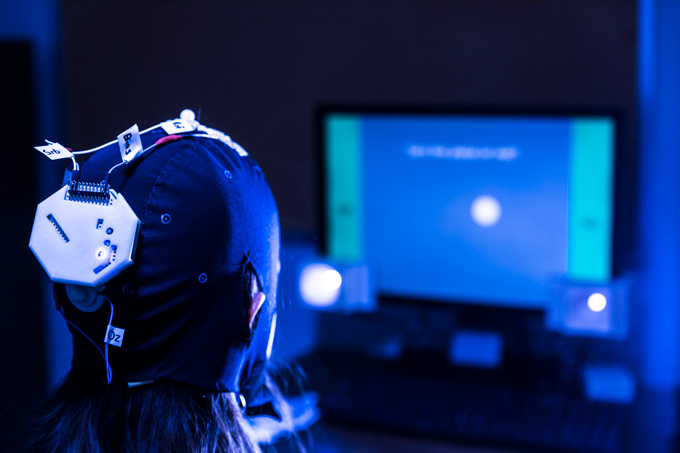
Other projects have looped in animals, though no birds yet. In 2019, people took control of six awake rats’ brains, guiding the animals’ movements through mazes via thought. A well-trained rat cyborg could reach turning accuracy of nearly 100 percent, the researchers reported.
But those rats took commands from a person; they did not send information back. Continuous back-and-forth exchanges are a prerequisite for an accomplishment like Harry’s.
These types of experiments are happening too. A recent study linked three monkeys’ brains, allowing their minds to collectively move an avatar arm on a 3-D screen. Each monkey was in charge of moving in two of three dimensions; left or right, up or down, and near or far. Those overlapping yet distinct jobs caused the networked monkeys to flounder initially. But soon enough, their neural cooperation became seamless as they learned to move the avatar arm to be rewarded with a sip of juice.
With technological improvements, the variety of signals that can move between brains will increase. And with that, these brain collectives might be able to accomplish even more. “One brain can do only so much, but if you bring many brains together, directly connected in a network, it’s possible that they could create inventions that no single mind could think of by itself,” Rao says.
Groups of brains might be extra good at certain jobs. A collective of surgeons, for instance, could pool their expertise for a particularly difficult operation. A collective of fast-thinking pilots could drive a drone over hostile territory. A collective of intelligence experts could sift through murky espionage material.
Maybe one day, information from an animal’s brain might augment human brains — although it’s unlikely that the neural signals from a well-trained Clark’s nutcracker will be the top choice for a memory aid. Artificial intelligence, or even human intelligence, might make better memory partners. Whatever the source, these external “nodes” could ultimately expand and change a human brain’s connectome.
Still, connecting brains directly is fraught with ethical questions. One aspect, the idea of an “extended mind,” poses particularly wild conundrums, says bioethicist Elisabeth Hildt of the Illinois Institute of Technology in Chicago.
“Part of me is connected and extended to this other human being,” she says. “Is this me? Is this someone else? Am I doing this myself?” she asks.
Some scientists think it’s too early to contemplate what it might feel like to have our minds dispersed across multiple brains (SN: 2/13/21, p. 24). Others disagree. “It may be too late if we wait until we understand the brain to study the ethics of brain interfacing,” Rao says. “The technology is already racing ahead.”
So feel free to mull over how it would feel to connect minds with a bird. If you were the human who could link to the mind of Harry the Clark’s nutcracker, for instance, perhaps you might start to dream of flying.
Science future: thoughts for sale
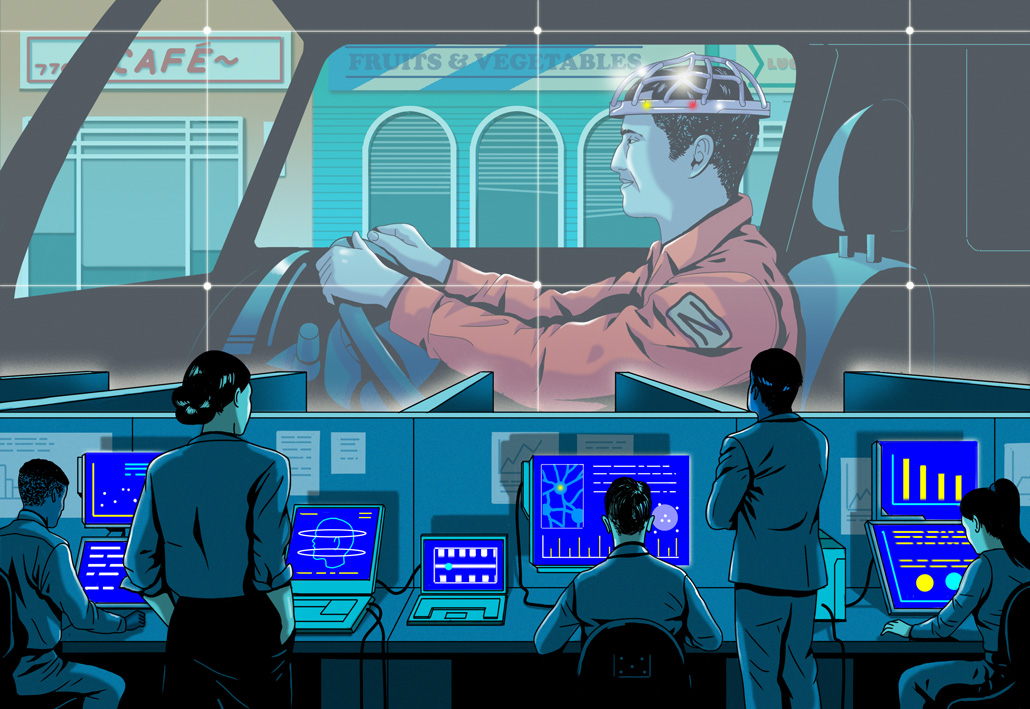
Javier had just been fired. “They’re done with me,” he told his coworker Marcus. “They’re done with the whole Signal program.”
Marcus shook his head. “I’m sorry, man.”
Javier went on: “It gets worse; they’re moving all of Signal’s data into the information market.”
The two were in the transportation business. Javier was the director of neural systems engagement for Zou, an on-demand ride hailing and courier system in Los Angeles. After the self-driving industry imploded because of too many accidents, Zou drove into L.A. with a promise of safety — so the company needed to make sure its drivers were the best.
That’s where Javier and his team came in. The ambitious idea of the Signal program was to incentivize drivers with cash, using their brain data, gathered by gray headsets.
Drivers with alert and focused brains earned automatic bonuses; a green power bar on-screen in the car showed minute-to-minute earnings. Drivers whose brains appeared sluggish or aggressive didn’t earn extra. Instead, they were warned. If the problem continued, they were fired.
This carrot-and-stick system, developed by Javier and his team, worked beautifully at first. But a few months in, accidents started creeping back up.
The problem, it turned out, was the brain itself: It changes. Human brains learn, find creative solutions, remake themselves. Incentivized to maintain a certain type of brain activity, drivers’ brains quickly learned to produce those signals — even if they didn’t correspond to better driving. Neural work-arounds sparked a race that Javier ultimately lost.
That failure was made worse by Zou’s latest plans. What had started as a driving experiment had morphed into an irresistible way for the company to make money. The plan was to gather and sell valuable data — information on how the drivers’ brains responded to a certain style of music, how excited drivers got when they saw a digital billboard for a vacation resort and how they reacted to a politician’s promises.
Zou was going to require employees to wear the headsets when they weren’t driving. The caps would collect data while the drivers ate, while they grocery shopped and while they talked with their kids, slurping up personal neural details and selling them to the highest bidders.
Of course, the employees could refuse. They could decide to take off the caps and quit. “But what kind of choice is that?” Javier asked. “Most of these drivers would open up their skulls for a paycheck.”
Marcus shook his head, and then asked, “How much extra are they going to pay?”
“Who knows,” Javier said. “Maybe nothing. Maybe they’ll just slip the data consent line into the standard contract.”
The two men looked at each other and shook their heads in unison. There wasn’t much left to say.
Reality check: thoughts for sale
Javier’s fictional program, Signal, was built with information gleaned externally from drivers’ brains. Today’s technology isn’t there yet. But it’s tiptoeing closer.
Some companies already sell brain monitoring systems made of electrodes that measure external brain waves with a method called electroencephalography. For now, these headsets are sold as wellness devices. For a few hundred dollars, you can own a headset that promises to fine-tune your meditation practice, help you make better decisions or even level up your golf game. EEG caps can measure alertness already; some controversial experiments have monitored schoolchildren as they listened to their teacher.
The claims by these companies are big, and they haven’t been proven to deliver. “It is unclear whether consumer EEG devices can reveal much of anything,” ethicist Anna Wexler of the University of Pennsylvania argued in a commentary in Nature Biotechnology in 2019. Still, improvements in these devices, and the algorithms that decode the signals they detect, may someday enable more sophisticated information to be reliably pulled from the brain.
Other types of technology, such as functional MRI scans, can pull more detailed information from the brain.
Complex visual scenes, including clips of movies that people were watching, can be extracted from brain scans. Psychologist Jack Gallant and colleagues at the University of California, Berkeley built captivating visual scenes using data from people’s brains as they lay in an fMRI scanner. A big red bird swooped across the screen, elephants marched in a row and Steve Martin walked across the screen, all impressionistic versions of images pulled from people’s brain activity.
That work, published in 2011, foreshadowed ever more complex brain-reading tricks. More recently, researchers used fMRI signals to re-create faces that people were seeing.
Visual scenes are one thing; will our more nebulous thoughts, beliefs and memories ever be accessible? It’s not impossible. Take a study from Japan, published in 2013. Scientists identified the contents of three sleeping people’s dreams, using an fMRI machine. But re-creating those dreams required hours of someone telling a scientist about other dreams first. To get the data they wanted, scientists first needed to be invited into the dreamers’ minds, in a way. Those three people were each awakened over 200 times early in the experiments and asked to describe what they had been dreaming about.
More portable and more reliable ways to eavesdrop on the brain from the outside are moving forward fast, a swiftness that has prompted some ethicists, scientists and futurists to call for special protections of neural data. Debates over who can access our brain activity, and for what purposes, will only grow more intense as the technology improves.

